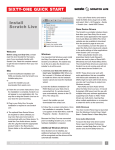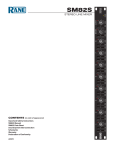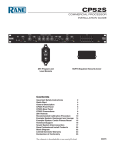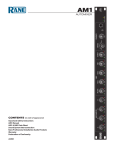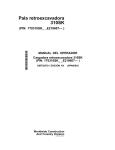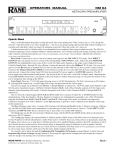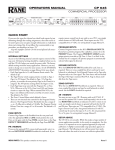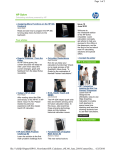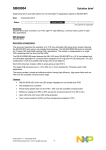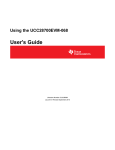Download Rane MS1S Specifications
Transcript
MS1S MIC STAGE Contents FCC Statement 2 Important Safety Instructions 3 Features6 General Description 6 Application Information 7 Features and Specifications 9 Block Diagram 10 Architectural Specifications 10 Unit Dimensions 11 Sound System Interconnection 12 Schematic28 Warranty31 Declaration of Conformity 34 21591 FCC Statement NOTE: This equipment has been tested and found to comply with the limits for a Class B digital device, pursuant to part 15 of the FCC Rules. These limits are designed to provide reasonable protection against harmful interference in a residential installation. This equipment generates, uses and can radiate radio frequency energy and, if not installed and used in accordance with the instructions, may cause harmful interference to radio communications. However, there is no guarantee that interference will not occur in a particular installation. If this equipment does cause harmful interference to radio or television reception, which can be determined by turning the equipment off and on, the user is encouraged to try to correct the interference by one or more of the following measures: • Reorient or relocate the receiving antenna. • Increase the separation between the equipment and receiver. • Connect the equipment into an outlet on a circuit different from that to which the receiver is connected. • Consult the dealer or an experienced radio/TV technician for help. CAUTION: Changes or modifications not expressly approved by Rane Corporation could void the user's authority to operate the equipment. This Class B digital apparatus complies with Canadian ICES-003. Cet appareil numérique de la classe B est conforme à la norme NMB-003 du Canada. WARNING CAUTION RISK OF ELECTRIC SHOCK DO NOT OPEN ATTENTION: RISQUE DE CHOCS ELECTRIQUE - NE PAS OUVRIR To reduce the risk of electrical shock, do not open the unit. No user serviceable parts inside. Refer servicing to qualified service personnel. The symbols shown below are internationally accepted symbols that warn of potential hazards with electrical products. This symbol indicates that a dangerous voltage constituting a risk of electric shock is present within this unit. This symbol indicates that there are important operating and maintenance instructions in the literature accompanying this unit. 2 Important Safety Instructions 1. Read these instructions. 2. Keep these instructions. 3. Heed all warnings. 4. Follow all instructions. 5. Do not use this apparatus near water. 6. Clean only with a dry cloth. 7. Do not block any ventilation openings. Install in accordance with manufacturer’s instructions. 8. Do not install near any heat sources such as radiators, registers, stoves, or other apparatus (including amplifiers) that produce heat. 9. Do not defeat the safety purpose of the polarized or grounding-type plug. A polarized plug has two blades with one wider than the other. A groundingtype plug has two blades and a third grounding prong. The wide blade or third prong is provided for your safety. If the provided plug does not fit into your outlet, consult an electrician for replacement of the obsolete outlet. 10. Protect the power cord and plug from being walked on or pinched particularly at plugs, convenience receptacles, and the point where it exits from the apparatus. 11. Only use attachments and accessories specified by Rane. 12. Use only with the cart, stand, tripod, bracket, or table specified by the manufacturer, or sold with the apparatus. When a cart is used, use caution when moving the cart/apparatus combination to avoid injury from tip-over. 13. Unplug this apparatus during lightning storms or when unused for long periods of time. 14. Refer all servicing to qualified service personnel. Servicing is required when the apparatus has been damaged in any way, such as power supply cord or plug is damaged, liquid has been spilled or objects have fallen into the apparatus, the apparatus has been exposed to rain or moisture, does not operate normally, or has been dropped. 15. The plug on the power cord is the AC mains disconnect device and must remain readily operable. To completely disconnect this apparatus from the AC mains, disconnect the power supply cord plug from the AC receptacle. 16. This apparatus shall be connected to a mains socket outlet with a protective earthing connection. 17. When permanently connected, an all-pole mains switch with a contact separation of at least 3 mm in each pole shall be incorporated in the electrical installation of the building. WARNING: To reduce the risk of fire or electric shock, do not expose this apparatus to rain or moisture. Apparatus shall not be exposed to dripping or splashing and no objects filled with liquids, such as vases, shall be placed on the apparatus. WARNING: This product may contain chemicals known to the State of California to cause cancer, or birth defects or other reproductive harm. 3 FCC REMARQUE: Cet équipement a été testé et approuvé conforme aux limites pour un appareil numérique de classe B, conformément au chapitre 15 des règles de la FCC. Ces limites sont établis pour fournir une protection raisonnable contre tout risque d’interférences et peuvent provoquer une énergie de radiofréquence s'il n'est pas installé et utilisé conformément aux instructions, peut également provoquer des interférences aux niveaux des équipements de communication. Cependant, il n'existe aucune garantie que de telles interférences ne se produiront pas dans une installation particulière. Si cet équipement provoque des interférences en réception radio ou télévision, ceci peut être detecté en mettant l'équipement sous/hors tension, l'utilisateur est encouragé à essayer de corriger cette interférence par une ou plusieurs des mesures suivantes: • Réorienter ou déplacer l'antenne de réception. • Augmenter la distance entre l'équipement et le récepteur. • Connecter l'équipement à une sortie sur un circuit différent de celui sur lequel le récepteur est branché. • Consulter un revendeur ou un technicien radio / TV expérimenté. ATTENTION: Les changements ou modifications non expressément approuvés par Rane Corporation peuvent annuler l'autorité de l'utilisateur à manipuler cet équipement et rendre ainsi nulles toutes les conditions de garantie. Cet appareil numérique de classe B est conforme à la norme Canadienne ICES-003. Cet appareil numérique de classe B est conforme à la norme Canadienne NMB-003. ATTENTION CAUTION RISK OF ELECTRIC SHOCK DO NOT OPEN ATTENTION: RISQUE DE CHOCS ELECTRIQUE - NE PAS OUVRIR Afin d’éviter tout risque de choc électrique, ne pas ouvrir l’appareil. Aucune pièce ne peut être changée par l’utilisateur. Contactez un SAV qualifié pour toute intervention. Les symboles ci-dessous sont reconnus internationalement comme prévenant tout risque électrique. Ce symbole indique que cette unité utilise un voltage élevé constituant un risque de choc électrique. Ce symbole indique la présence d’instructions d’utilisation et de maintenance importantes dans le document fourni. 4 INSTRUCTIONS DE SÉCURITÉ 1. Lisez ces instructions. 2. Gardez précieusement ces instructions. 3. Respectez les avertissements. 4. Suivez toutes les instructions. 5. Ne pas utiliser près d’une source d’eau. 6. Ne nettoyer qu’avec un chiffon doux. 7. N’obstruer aucune évacuation d’air. Effectuez l’installation en suivant les instructions du fabricant. 8. Ne pas disposer près d’une source de chaleur, c-à-d tout appareil produisant de la chaleur sans exception. 9. Ne pas modifier le cordon d’alimentation. Un cordon polarisé possède 2 lames, l’une plus large que l’autre. Un cordon avec tresse de masse possède 2 lames plus une 3è pour la terre. La lame large ou la tresse de masse assurent votre sécurité. Si le cordon fourni ne correspond pas à votre prise, contactez votre électricien. 10. Faites en sorte que le cordon ne soit pas piétiné, ni au niveau du fil, ni au niveau de ses broches, ni au niveau des connecteurs de vos appareils. 11. N’utilisez que des accessoires recommandés par Rane. 12. N’utilisez que les éléments de transport, stands, pieds ou tables spécifiés par le fabricant ou vendu avec l’appareil. Quand vous utlisez une valise de transport, prenez soin de vous déplacer avec cet équipement avec prudence afin d’éviter tout risque de blessure. 13. Débranchez cet appareil pendant un orage ou si vous ne l’utilisez pas pendant un certain temps. 14. Adressez-vous à du personnel qualifié pour tout service après vente. Celui-ci est nécessaire dans n’importe quel cas où l’appareil est abimé : si le cordon ou les fiches sont endommagés, si du liquide a été renversé ou si des objets sont tombés sur l’appareil, si celui-ci a été exposé à la pluie ou l’humidité, s’il ne fonctionne pas correctement ou est tombé. 15. La fiche du cordon d’alimentation sert à brancher le courant alternatif AC et doit absolument rester accessible. Pour déconnecter totalement l’appareil du secteur, débranchez le câble d’alimentation de la prise secteur. 16. Cet appareil doit être branché à une prise terre avec protection. 17. Quand il est branché de manière permanente, un disjoncteur tripolaire normalisé doit être incorporé dans l’installation électrique de l’immeuble. 18. En cas de montage en rack, laissez un espace suffisant pour la ventilation. Vous pouvez disposer d’autres appareils au-dessus ou en-dessous de celui-ci, mais certains (tels que de gros amplificateurs) peuvent provoquer un buzz ou générer trop de chaleur au risque d’endommager votre appareil et dégrader ses performances. 19. Cet appareil peut-être installé dans une baie standard ou un chassis normalisé pour un montage en rack. Visser chaque trou de chaque oreille de rack pour une meilleure fixation et sécurité. ATTENTION: afin d’éviter tout risque de feu ou de choc électrique, gardez cet appareil éloigné de toute source d’humidité et d’éclaboussures quelles qu’elles soient. L’appareil doit également être éloigné de tout objet possédant du liquide (boisson en bouteilles, vases,…). 5 MS1S MIC STAGE Features • • • • -127 dB Equivalent Input Noise Gain Control Signal / Overload Indicator Polarity Switch • • • • Switchable 48 V Phantom Power True Differential Input Cross-coupled Line Driver Internal 100-240 VAC Power Supply General Description The Rane MS1S Mic Stage preamplifier provides the answer when you need just one microphone input in an otherwise line-level world. Give us a call to go from either a dynamic, condenser or electret microphone to a line-level input with a minimum of noise, distortion, cost and hassle. The MS1S provides 48 V switchable Phantom Power with an indicator LED, continuous rotary Gain trim between 15 dB and 60 dB, Signal/Overload LED, and XLR balanced Input & Output connectors. A Polarity switch and high-current cross-coupled output line driver round out the features. The MS1S utilizes one of the finest ultra low noise amplifier designs available. Featuring a true differential input with high common-mode rejection, use of the MS1S guarantees performance usually found only in mixing consoles costing thousands of times as much. Of course, for all of that extra money you receive a proportional increase in KPSI (knobs per square inch). The MS1S replaced the MS 1B Mic Stage with a new internal universal power supply. The width increases by one inch, all other features are the same. 6 Application Information Uses and applications for the MS1S should be obvious. But then again, it’s obvious to us our taxes are too high and nothing is being done about that. With this in mind, perhaps a few words on using the MS1S might not be wasted. BALANCED USE The MS1S provides a true cross-coupled balanced output. This is equivalent to an electronic simulation of a transformer output. Rane follows the AES standard of pin 2 = hot. When running a long cable back to the mixer, run a line-level balanced line rather than a mic-level line. The compact MS 1S can mount closer to the microphone, provide a local volume control (or not, just pull the knob off), while the stronger signal minimizes RF and hum irritations. UNBALANCED USE Balanced use is recommended to minimize noise. Unbalanced lines are usually quiet under 10 feet (3 meters), but longer runs will introduce the hum and interference you are trying to avoid. When you must drive an unbalanced device with the MS1S's balanced output, keep the cable short, and connect pin 2 to the “+” or “hot” lead, and tie pin 3 and ground together at the shield. MIXING The MS1S is designed to fill the need for adding a microphone channel to line-level mixers, such as the Rane SM 26S or SM 82S. Many installations using either of these products invariably wind up with one unused input that would do the job perfectly if only it could operate at mic-level. In rides the MS1S to the rescue. DIGITAL RECORDING AND SAMPLING Another handy use for the MS1S is in recording applications. Many popular products do not have a high enough quality mic preamp to suit the resolution of the digital processing electronics. Such irony. Using the ultra low noise MS1S to bring the mic inputs up to extremely high quality line-level is an easy and affordable solution for this dilemma. No garbage in; no garbage out. Clippity-clop; clippity-clop. MICROPHONE TYPES The available gain and large input range of the MS1S allows the use of virtually any type of microphone. True 48V phantom power guarantees the MS1S works with every microphone. The better the mic, the better the MS1S sounds. Ah, the sound of the thundering hoofs is deafening. 7 Features and Specifications Parameter Specification Input Impedance 2k Gain Range 15 to 60 Phantom Power +48 ..........Impedance 6.81k Max. Input Level +9 / -35 Equivalent Input Noise -127 Signal to Noise Ratio 94 Dynamic Range 114 / 91 CMRR 80 Frequency Response 3 to 200k THD+Noise (gain 60 dB) .004 (Output=+20 dBu) THD+Noise (gain 15 dB) .0006 (Output=+20 dBu) Line Driver Active Cross-coupled Max. Output Level +18 / +24 Output Impedance 94 Signal Indicator -11 Overload Indicator +20 Output Cable Length 1000 feet / 300 meters Unit: Conformity FCC, CCSAUS Maximum Power 3 Universal Line Voltage 100-240 Power Cord C5 cord to C6 inlet Unit: Size 1.64"H x 6.8"W x 4.26"D ..........Weight 1 lb 1 oz Shipping Size 3.6"H x 11.75"W x 7.2"D ..........Weight 4 lb © R a n e Co r p o r a t i o n 8 1 0 8 0 2 4 7 t h Ave . W. , M u k i l t e o WA 9 8 2 7 5 - 5 0 0 0 Limit Units Conditions/Comments 1% Ω Balanced typ. dB 4% V 10 mA max. 1% Ω Each leg min. dBu Gain 15 / 60, balanced output typ. dBu 20 kHz BW, Rs=150 Ω, Gain = 60 dB typ. dB 20 kHz BW, Rs=150 Ω, Gain = 15 dB, re 4 dBu typ. dB Gain 15 / 60, 20 Hz to 20 kHz typ. dB Rs=150 Ω, 120 Hz, Gain = 60 dB typ. Hz +0, -3dB typ. % 55 Hz to 20 kHz, 20 kHz BW, Rl=10 kΩ typ. % 50 Hz to 20 kHz, 20 kHz BW, Rl=10 kΩ min. dBu Balanced, 2 kΩ load 1% Ω Each Leg typ. dBu Balanced output, Green LED typ. dBu Balanced output, Amber LED typ. Belden 8451 or equivalent W VAC 50/60 Hz IEC 60320-1 (4.2 cm x 17.3 cm x 10.8 cm) (0.5 kg) (9.5 cm x 30 cm x 18 cm) (1.8 kg) USA TEL 425-355-6000 FA X 4 2 5 - 3 4 7 - 7 7 5 7 WEB rane.com 9 Block Diagram +48V PHANTOM POWER SIGNAL / OVERLOAD INVERT MIC INPUT 2 3 1 RFI +6 dB FILTER 2 1 LINE LEVEL 3 OUT GAIN 12-60 dB Architectural Specifications The microphone preamplifier shall be a single channel stand-alone unit with a removable IEC power cord. The unit shall accept voltages from 100 to 240 VAC. The input and output shall be fitted with XLR connectors. A polarity inverting switch shall be included. Phantom power of no less than 48 volts shall be provided in compliance with IEC 60268-15 and be controlled by a slide switch with an LED indicator. A gain control shall be provided with 1866 dB adjustment range. Power, system signal and overload indicators shall be provided. High current cross-coupled active output line driver shall be standard, as well as input RFI filter protection. The unit shall be a Rane MS1S Microphone Stage. All features & specifications subject to change without notice. 10 Unit Dimensions 6.1" 6 8 MIN MS1S ON MAX 1.636" 4 2 MIC STAGE GAIN SIG OL 48V PHANTOM POWER 2.5" 4.225" 4.26" 0.775" 0.15" .7" 0.35" 6.8" 100-240 V 50/60 Hz 3 WATTS MS1S NORMAL POWER PIN 2: (+) PIN 3: (–) PIN 1: MADE IN U.S.A. RANE CORP. INVERT POLARITY LINE OUT MIC IN 11 RaneNote Sound System Interconnection • Cause & prevention of ground loops • Interfacing balanced & unbalanced • Proper pin connections and wiring • Chassis ground vs. signal ground • Ground lift switches Rane Technical Staff RaneNote 110 © 1985, 1995, 2006, 2007, 2011 Rane Corporation 12 Introduction This note, originally written in 1985, continues to be one of our most useful references. It’s popularity stems from the continual and perpetual difficulty of hooking up audio equipment without suffering through all sorts of bizarre noises, hums, buzzes, whistles, etc.— not to mention the extreme financial, physical and psychological price. As technology progresses it is inevitable that electronic equipment and its wiring should be subject to constant improvement. Many things have improved in the audio industry since 1985, but unfortunately wiring isn’t one of them. However, finally the Audio Engineering Society (AES) has issued a standards document for interconnection of pro audio equipment. It is AES48, titled “AES48-2005: AES standard on interconnections —Grounding and EMC practices — Shields of connectors in audio equipment containing active circuitry.” Rane’s policy is to accommodate rather than dictate. However, this document contains suggestions for external wiring changes that should ideally only be implemented by trained technical personnel. Safety regulations require that all original grounding means provided from the factory be left intact for safe operation. No guarantee of responsibility for incidental or consequential damages can be provided. (In other words, don’t modify cables, or try your own version of grounding unless you really understand exactly what type of output and input you have to connect.) 13 Ground Loops Almost all cases of noise can be traced directly to ground loops, grounding or lack thereof. It is important to understand the mechanism that causes grounding noise in order to effectively eliminate it. Each component of a sound system produces its own ground internally. This ground is usually called the audio signal ground. Connecting devices together with the interconnecting cables can tie the signal grounds of the two units together in one place through the conductors in the cable. Ground loops occur when the grounds of the two units are also tied together in another place: via the third wire in the line cord, by tying the metal chassis together through the rack rails, etc. These situations create a circuit through which current may flow in a closed “loop” from one unit’s ground out to a second unit and back to the first. It is not simply the presence of this current that creates the hum—it is when this current flows through a unit’s audio signal ground that creates the hum. In fact, even without a ground loop, a little noise current always flows through every interconnecting cable (i.e., it is impossible to eliminate these currents entirely). The mere presence of this ground loop current is no cause for alarm if your system uses properly implemented and completely balanced interconnects, which are excellent at rejecting ground loop and other noise currents. Balanced interconnect was developed to be immune to these noise currents, which can never be entirely eliminated. What makes a ground loop current annoying is when the audio signal is affected. Unfortunately, many manufacturers of balanced audio equipment design the internal grounding system improperly, thus creating balanced equipment that is not immune to the cabling’s noise currents. This is one reason for the bad reputation sometimes given to balanced interconnect. A second reason for balanced interconnect’s bad reputation comes from those who think connecting unbalanced equipment into “superior” balanced equipment should improve things. Sorry. Balanced interconnect is not compatible with unbalanced. The small physical nature and short cable runs of completely unbalanced systems (home audio) also contain these ground loop noise currents. However, the currents in unbalanced systems never get large enough to affect the audio to the point where it is a nuisance. Mixing balanced and unbalanced equipment, however, is an entirely different story, since balanced and unbalanced interconnect are truly not compatible. The rest of this note shows several recommended implementations for all of these interconnection schemes. The potential or voltage which pushes these noise currents through the circuit is developed between the independent grounds of the two or more units in the system. The impedance of this circuit is low, and even though the voltage is low, the current is high, thanks to Mr. Ohm, without whose help we wouldn’t have these problems. It would take a very high resolution ohm meter to measure the impedance of the steel chassis or the rack rails. We’re talking thousandths of an ohm. So trying to measure this stuff won’t necessarily help you. We just thought we’d warn you. 14 The Absolute Best Right Way To Do It The method specified by AES48 is to use balanced lines and tie the cable shield to the metal chassis (right where it enters the chassis) at both ends of the cable. A balanced line requires three separate conductors, two of which are signal (+ and –) and one shield (see Figure 1a). The shield serves to guard the sensitive audio lines from interference. Only by using balanced line interconnects can you guarantee (yes, guarantee) hum-free results. Always use twisted pair cable. Chassis tying the shield at each end also guarantees the best possible protection from RFI [radio frequency interference] and other noises [neon signs, lighting dimmers]. Neil Muncy1, an electroacoustic consultant and seasoned veteran of years of successful system design, chairs the AES Standards Committee (SC-05-05) working on this subject. He tirelessly tours the world giving seminars and dispensing information on how to successfully hook-up pro audio equipment2. He makes the simple point that it is absurd that you cannot go out and buy pro audio equipment from several different manufacturers, buy standard offthe-shelf cable assemblies, come home, hook it all up and have it work hum and noise free. Plug and play. Sadly, almost never is this the case, despite the science and rules of noise-free interconnect known and documented for over 60 years (see References for complete information). It all boils down to using balanced lines, only balanced lines, and nothing but balanced lines. This is why they were developed. Further, that you tie the shield to the chassis, at the point it enters the chassis, and at both ends of the cable (more on ‘both ends’ later). Since standard XLR cables come with their shields tied to pin 1 at each end (the shells are not tied, nor need be), this means equipment using 3-pin, XLR-type connectors must tie pin 1 to the chassis (usually called chassis ground) — not the audio signal ground as is most common. Not using signal ground is the most radical departure from common proaudio practice. Not that there is any argument about its validity. There isn’t. This is the right way to do it. So why doesn’t audio equipment come wired this way? Well, some does, and since 1993, more of it does. That’s when Rane started manufacturing some of its products with balanced inputs and outputs tying pin 1 to chassis. So why doesn’t everyone do it this way? Because life is messy, some things are hard to change, and there will always be equipment in use that was made before proper grounding practices were in effect. Unbalanced equipment is another problem: it is everwhere, easily available and inexpensive. All those RCA and ¼" TS connectors found on consumer equipment; effect-loops and insert-points on consoles; signal processing boxes; digital and analog tape recorders; computer cards; mixing consoles; et cetera. The next several pages give tips on how to successfully address hooking up unbalanced equipment. Unbalanced equipment when “blindly” connected with fully balanced units starts a pattern of hum and undesirable operation, requiring extra measures to correct the situation. 15 CHASSIS GROUND R S T MALE RED BLACK SHIELD FEMALE RED 2 BLACK 3 C 3 SHIELD 1 1 2 G – + BALANCED OUTPUTS 16 RED BLACK SHIELD RED BLACK SHIELD Figure 1a. The right way to do it. 2-CONDUCTOR SHIELDED CABLE 2-CONDUCTOR SHIELDED CABLE 2-CONDUCTOR SHIELDED CABLE RED BLACK SHIELD RED BLACK SHIELD MALE 1 2 3 G – + CHASSIS SIGNAL GROUND GROUND R S T FEMALE 2 C 3 1 BALANCED INPUTS COMMON (WRONG) PRACTICE (+) CASE RECOMMENDED PRACTICE (+) CASE OPTIONAL 2 2 (–) 3 3 1 CHASSIS GROUND (–) 1 SIGNAL GROUND CHASSIS GROUND CHASSIS GROUND Figure 1b. Recommmended practice. The Next Best Right Way To Do It The quickest, quietest and most foolproof method to connect balanced and unbalanced is to transformer isolate all unbalanced connections. See Figure 2. Many manufacturers provide several tools for this task, including Rane. Consult your audio dealer to explore the options available. The goal of these adaptors is to allow the use of standard cables. With these transformer isolation boxes, modification of cable assemblies is unnecessary. Virtually any two pieces of audio equipment can be successfully interfaced without risk of unwanted hum and noise. Another way to create the necessary isolation is to use a direct box. Originally named for its use to convert the high impedance, high level output of an electric guitar to the low impedance, low level input of a recording console, it allowed the player to plug “directly” into the console. Now this term is commonly used to describe any box used to convert unbalanced lines to balanced lines. UNBALANCED BALANCED NOT CONNECTED AT CHASSIS (PLASTIC JACK) TRANSFORMER 1/4” TIP-SLEEVE 2 3 1 EARTH GROUNDED METAL ENCLOSURE CASE LUG MAY CONNECT TO CHASSIS (NOT REQUIRED) CHASSIS IS GROUNDED TO PIN 1 Figure 2. Transformer Isolation 17 The Last Best Right Way To Do It If transformer isolation is not an option, special cable assemblies are a last resort. The key here is to prevent the shield currents from flowing into a unit whose grounding scheme creates ground loops (hum) in the audio path (i.e., most audio equipment). It is true that connecting both ends of the shield is theoretically the best way to interconnect equipment –though this assumes the interconnected equipment is internally grounded properly. Since most equipment is not internally grounded properly, connecting both ends of the shield is not often practiced, since doing so usually creates noisy interconnections. A common solution to these noisy hum and buzz problems involves disconnecting one end of the shield, even though one can not buy off-the-shelf cables with the shield disconnected at one end. The best end to disconnect is the receiving end. If one end of the shield is disconnected, the noisy hum current stops flowing and away goes the hum — but only at low frequencies. A ground-sending-end-only shield connection minimizes the possibility of high frequency (radio) interference since it prevents the shield from acting as an antenna to the next input. Many reduce this potential RF interference by providing an RF path through a small capacitor (0.1 or 0.01 microfarad ceramic disc) connected from the lifted end of the shield to the chassis. (This is referred to as the “hybrid shield termination” where the sending end is bonded to the chassis and the receiving end is capacitively coupled. See Neutrik’s EMC-XLR for example.) The fact that many modern day installers still follow this one-end-only rule with consistent success indicates this and other acceptable solutions to RF issues exist, though the increasing use of digital and wireless technology greatly increases the possibility of future RF problems. If you’ve truly isolated your hum problem to a specific unit, chances are, even though the documentation indicates proper chassis grounded shields, the suspect unit is not internally grounded properly. Here is where special test cable assemblies, shown in Figure 3, really come in handy. These assemblies allow you to connect the shield to chassis ground at the point of entry, or to pin 1, or to lift one end of the shield. The task becomes more difficult when the unit you’ve isolated has multiple inputs and outputs. On a suspect unit with multiple cables, try various configurations on each connection to find out if special cable assemblies are needed at more than one point. FEMALE 2 C 3 1 RED BLACK SHIELD 2-CONDUCTOR SHIELDED CABLE RED BLACK SHIELD MALE 2 3 1 TEST WIRE Figure 3. Test cable 18 GROUND CLIP See Figure 4 for suggested cable assemblies for your particular interconnection needs. Find the appropriate output configuration (down the left side) and then match this with the correct input configuration (across the top of the page.) Then refer to the following pages for a recommended wiring diagram. Ground Lifts Many units come equipped with ground lift switches. In only a few cases can it be shown that a ground lift switch improves ground related noise. (Has a ground lift switch ever really worked for you?) In reality, the presence of a ground lift switch greatly reduces a unit’s ability to be “properly” grounded and therefore immune to ground loop hums and buzzes. Ground lifts are simply another Band-Aid ® to try in case of grounding problems. It is true that an entire system of properly grounded equipment, without ground lift switches, is guaranteed (yes guaranteed) to be hum free. The problem is most equipment is not (both internally and externally, AC system wise) grounded properly. Most units with ground lifts are shipped so the unit is “grounded” — meaning the chassis is connected to audio signal ground. (This should be the best and is the “safest” position for a ground lift switch.) If after hooking up your system it exhibits excessive hum or buzzing, there is an incompatibility somewhere in the system’s grounding configuration. In addition to these special cable assemblies that may help, here are some more things to try: 1. Try combinations of lifting grounds on units supplied with lift switches (or links). It is wise to do this with the power off! 2. If you have an entirely balanced system, verify all chassis are tied to a good earth ground, for safety’s sake and hum protection. Completely unbalanced systems never earth ground anything (except cable TV, often a ground loop source). If you have a mixed balanced and unbalanced system, do yourself a favor and use isolation transformers or, if you can’t do that, try the special cable assemblies described here and expect it to take many hours to get things quiet. May the Force be with you. 3. Balanced units with outboard power supplies (wall warts or “bumps” in the line cord) do not ground the chassis through the line cord. Make sure such units are solidly grounded by tying the chassis to an earth ground using a star washer for a reliable contact. (Rane always provides this chassis point as an external screw with a toothed washer.) Any device with a 3-prong AC plug, such as an amplifier, may serve as an earth ground point. Rack rails may or may not serve this purpose depending on screw locations and paint jobs. 19 Floating, Pseudo, and Quasi-Balancing During inspection, you may run across a ¼" output called floating unbalanced, sometimes also called psuedo-balanced or quasi-balanced. In this configuration, the sleeve of the output stage is not connected inside the unit and the ring is connected (usually through a small resistor) to the audio signal ground. This allows the tip and ring to “appear” as an equal impedance, notquite balanced output stage, even though the output circuitry is unbalanced. Floating unbalanced often works to drive either a balanced or unbalanced input, depending if a TS or TRS standard cable is plugged into it. When it hums, a special cable is required. See drawings #11 and #12, and do not make the cross-coupled modification of tying the ring and sleeve together. Winning the Wiring Wars • Use balanced connections whenever possible, with the shield bonded to the metal chassis at both ends. • Transformer isolate all unbalanced connections from balanced connections. • Use special cable assemblies when unbalanced lines cannot be transformer isolated. • Any unbalanced cable must be kept under 10 feet (3 m) in length. Lengths longer than this will amplify all the nasty side effects of unbalanced circuitry's ground loops. Summary If you are unable to do things correctly (i.e. use fully balanced wiring with shields tied to the chassis at both ends, or transformer isolate all unbalanced signals from balanced signals) then there is no guarantee that a hum-free interconnect can be achieved, nor is there a definite scheme that will assure noise-free operation in all configurations. 20 References 1. Neil A. Muncy, “Noise Susceptibility in Analog and Digital Signal Processing Systems,” presented at the 97th AES Convention of Audio Engineering Society in San Francisco, CA, Nov. 1994. 2. Grounding, Shielding, and Interconnections in Analog & Digital Signal Processing Systems: Understanding the Basics; Workshops designed and presented by Neil Muncy and Cal Perkins, at the 97th AES Convention of Audio Engineering Society in San Francisco, CA, Nov. 1994. 3. The entire June 1995 AES Journal, Vol. 43, No. 6, available $6 members, $11 nonmembers from the Audio Engineering Society, 60 E. 42nd St., New York, NY, 10165-2520. 4. Phillip Giddings, Audio System Design and Installation (SAMS, Indiana, 1990). 5. Ralph Morrison, Noise and Other Interfering Signals (Wiley, New York, 1992). 6. Henry W. Ott, Noise Reduction Techniques in Electronic Systems, 2nd Edition (Wiley, New York, 1988). 7. Cal Perkins, “Measurement Techniques for Debugging Electronic Systems and Their Instrumentation,” The Proceedings of the 11th International AES Conference: Audio Test & Measurement, Portland, OR, May 1992, pp. 8292 (Audio Engineering Society, New York, 1992). 8. Macatee, RaneNote: “Grounding and Shielding Audio Devices,” Rane Corporation, 1994. 9. Philip Giddings, “Grounding and Shielding for Sound and Video,” S&VC, Sept. 20th, 1995. 10. AES48-2005: AES standard on interconnections —Grounding and EMC practices — Shields of connectors in audio equipment containing active circuitry (Audio Engineering Society, New York, 2005). Band-Aid is a registered trademark of Johnson & Johnson Figures 4a, 4b, 4c. Interconnect chart for locating correct cable assemblies is on the following pages. Note: (A) This configuration uses an “off-the-shelf” cable. Note: (B) This configuration causes a 6 dB signal loss. Compensate by “turning the system up” 6 dB. 21 From Output 22 From Output ¼” FLOATING UNBALANCED ¼” BALANCED TRS (EITHER A TRANSFORMER OR A CROSS-COUPLED OUTPUT STAGE) ¼” BALANCED TRS (NOT A TRANSFORMER, NOR A CROSS-COUPLED OUTPUT STAGE) FEMALE BALANCED XLR (EITHER A TRANSFORMER OR A CROSS-COUPLED OUTPUT STAGE) FEMALE BALANCED XLR (NOT A TRANSFORMER, NOR A CROSS-COUPLED OUTPUT STAGE) CABLE CONNECTORS 8 22 7 21 A 8 7 A 2 2 1 1 ¼" BALANCED TRS (TIP-RING-SLEEVE) MALE BALANCED XLR 11 11 B 9 5 B 3 ¼" OR 3.5mm UNBALANCED TS (TIP-SLEEVE) To ToInput Input 12 12 B 10 6 B 4 UNBALANCED RCA GROUND to GROUND + to + – to – SHIELD NC + to + – to – SHIELD ONLY TO EUROBLOCK + to + – to – SHIELD NC + to + – to – SHIELD NC + to + – to – BALANCED EUROBLOCK From Output 23 From Output BALANCED EUROBLOCK UNBALANCED RCA (TIP-SLEEVE) ¼” OR 3.5 mm UNBALANCED TS (TIP-SLEEVE) ¼” FLOATING UNBALANCED TRS (TIP-RING-SLEEVE) (SLEEVE IN UNIT = NC) ¼” BALANCED TRS (EITHER A TRANSFORMER OR A CROSS-COUPLED OUTPUT STAGE) ¼” BALANCED TRS (NOT A TRANSFORMER, NOR A CROSS-COUPLED OUTPUT STAGE) + to + – to – + to + – to – SHIELD ONLY TO TRS SLEEVE 18 17 SHIELD ONLY TO XLR PIN 1 14 13 A 22 21 A 8 7 To Input 8 7 24 A 19 A 15 11 11 B 9 24 A 20 A 16 12 12 B 10 GROUND to GROUND + to + – to – 23 23 GROUND to GROUND + to + – to – SHIELD NC + to + – to – SHIELD ONLY TO EUROBLOCK + to + – to – From Output Output 24 6 T=RED RED FEMALE 1=SHIELD RED 2 2-CONDUCTOR SHIELDED CABLE BLACK 2=RED C 3 SHIELD 3=BLACK 1 CROSS-COUPLED OUTPUT ONLY: CONNECT PIN 1 TO PIN 3 AT THIS END AND SET GROUND LIFT SWITCH TO ‘GROUNDED’ (IF PRESENT). FEMALE 1=SHIELD RED 2 2-CONDUCTOR SHIELDED CABLE 2=RED BLACK C 3 3=BLACK SHIELD 1 CROSS-COUPLED OUTPUT ONLY: CONNECT PIN 1 TO PIN 3 AT THIS END AND SET GROUND LIFT SWITCH TO ‘GROUNDED’ (IF PRESENT). 1-CONDUCTOR SHIELDED CABLE FEMALE 1=SHIELD RED 2 2=RED C 3 3=NC SHIELD 1 4B 5 1-CONDUCTOR SHIELDED CABLE FEMALE 1=SHIELD RED 2 2=RED C 3 3=NC SHIELD 1 2-CONDUCTOR SHIELDED CABLE FEMALE 1=SHIELD RED 2 2=RED BLACK C 3 3=BLACK SHIELD 1 2 3B 2-CONDUCTOR SHIELDED CABLE 1 RED BLACK SHIELD RED RED BLACK N/C RED RED BLACK SHIELD RED RED BLACK N/C MALE MALE 1 2 3 1=NC T=RED S=BLACK T=RED S=BLACK T=RED S=SHIELD T=RED S=SHIELD T=RED R=BLACK S=NC 1=NC 2=RED 3=BLACK nput FEMALE 1=SHIELD RED 2 2=RED BLACK C 3 3=BLACK SHIELD 1 To Input From O T=RED R=NC S=SHIELD 9B RED BLACK SHIELD T=RED R=BLACK S=SHIELD T=RED R=BLACK S=SHIELD 11 12 2-CONDUCTOR SHIELDED CABLE 1-CONDUCTOR SHIELDED CABLE 1-CONDUCTOR SHIELDED CABLE 2-CONDUCTOR SHIELDED CABLE 2-CONDUCTOR SHIELDED CABLE RED BLACK SHIELD RED RED BLACK N/C SHIELD RED RED BLACK N/C RED RED 2-CONDUCTOR SHIELDED CABLE BLACK BLACK SHIELD CROSS-COUPLED OUTPUT ONLY: CONNECT RING TO SLEEVE AT THIS END AND SET GROUND LIFT SWITCH TO ‘GROUNDED’ (IF PRESENT). CROSS-COUPLED OUTPUT ONLY: CONNECT RING TO SLEEVE AT THIS END AND SET GROUND LIFT SWITCH TO ‘GROUNDED’ (IF PRESENT). SHIELD RED SHIELD 10B R=NC S=SHIELD T=RED RED BLACK SHIELD T=RED R=BLACK S=SHIELD 8 RED RED BLACK SHIELD T=RED R=BLACK S=SHIELD 7 CROSS-COUPLED OUTPUT ONLY: CONNECT PIN 1 TO PIN 3 AT THIS END AND SET GROUND LIFT SWITCH TO ‘GROUNDED’ (IF PRESENT). MALE 1 2 3 T=RED S=BLACK T=RED S=BLACK T=RED S=SHIELD T=RED S=BLACK T=RED R=BLACK S=NC 1=NC 2=RED 3=BLACK To Inp To Input From Output 25 From Output m Output 26 18 17 16A 15A 14 13 T=RED S=BLACK T=RED S=BLACK T=RED S=SHIELD T=RED S=SHIELD T=RED S=BLACK T=RED S=BLACK 2-CONDUCTOR SHIELDED CABLE 2-CONDUCTOR SHIELDED CABLE RED BLACK 1-CONDUCTOR SHIELDED CABLE RED BLACK SHIELD RED SHIELD 1-CONDUCTOR SHIELDED CABLE 2-CONDUCTOR SHIELDED CABLE RED BLACK N/C RED 2-CONDUCTOR SHIELDED CABLE RED BLACK SHIELD SHIELD RED RED BLACK SHIELD RED BLACK SHIELD SHIELD RED RED BLACK SHIELD MALE MALE 1 2 3 T=RED R=BLACK S=SHIELD 1=SHIELD 2=RED 3=BLACK T=RED S=SHIELD T=RED S=SHIELD T=RED R=BLACK S=SHIELD 1=SHIELD 3 2=RED 3=BLACK 1 2 o Input RED BLACK N/C To Input 24 23 – + RED BLACK SHIELD 2-CONDUCTOR SHIELDED CABLE 2-CONDUCTOR SHIELDED CABLE 2-CONDUCTOR SHIELDED CABLE 2-CONDUCTOR SHIELDED CABLE 1-CONDUCTOR SHIELDED CABLE 1-CONDUCTOR SHIELDED CABLE RED RED BLACK SHIELD SHIELD RED MALE 1 2 3 T=RED R=BLACK S=SHIELD 1=SHIELD 2=RED 3=BLACK T=RED S=SHIELD (CHECK: NO STANDARD POLARITY ON EUROBLOCKS) RED + BLACK SHIELD – RED BLACK SHIELD SHIELD T=RED S=SHIELD RED (ANY UNBALANCED CONNECTOR) T=RED BLACK S=BLACK CROSS-COUPLED OUTPUT ONLY: CONNECT BLACK TO SHIELD AT THIS END AND SET GROUND LIFT SWITCH TO ‘GROUNDED’ (IF PRESENT). (CHECK: NO STANDARD POLARITY ON EUROBLOCKS) (ANY UNBALANCED CONNECTOR) RED BLACK T=RED S=BLACK RED BLACK SHIELD 22A 21 T=RED R=BLACK S=SHIELD SHIELD RED SHIELD RED RED BLACK SHIELD T=RED S=SHIELD T=RED S=SHIELD T=RED R=BLACK A S=SHIELD 20A 19A To To Input From From Output 27 Schematic UN-USED R1C 2kRD 6 5 6 4 R1B 2kRD U2B 5 GND 7 072 GND PHANTOM POWER 2.00k RED GND +12 GND Z2 + 1SMB51CAT3 GND R1A 2kRD GND 2 U1 1512 13 R16 5.10 R18 1 GAIN R14 10.0k 5 + 3 G1 8 C5 0.0033 GND C7 2200pF D10 GND 2 47/50v 22.0 R15 2.67k g=0.5 + (5k/Rg) D6 MBRS3100 V12 V+ 4 G2 - 47/50v 22.0 C6 0.0033 GND D14 MBRS3100 +12 R17 10.0k D13 MBRS3100 +12 C9 -12 GND 0.1 F3 P1 T 1A 250V 27.0 4 GND J3 IEC PWR 3 H 2 G 1 N SEN REF 1 2 D15 DF06M -12 C10 C11 0.1 0.1 GND L1 1000uH 3 D17 P6SMB160AT C24 0.0022 X1Y2 H1 R22 R23 1.50k 1.50k C19 + 6.8/400v D19 MURS160 C20 + 6.8/400v C25 0.0022 X1Y2 L5 1000uH 2/6/2012 C:\CAD Projects\MS1S\MS1S-1.SchDoc 28 9 10 GND R12 6 2200pF D7 GND C4 -12 D5 MBRS3100 1 Z1 + + MIC INPUT 2 3 1 R11 6.81k 1SMB51CAT3 J1 R10 6.81k 14 +12 7 +48 GND D4 R8 11 4 5 6 S1B 2P2T 3 GND S1A 2P2T 1 2 3 7 8 S1C 2P2T Main C8 0.1 -12 6 R2 10.0k U4B 5 R5 5817 2 R7 C1 + 100k 1/50v GND GND 3 R9 51.1 OL +12 D3 R6 1 U4A 4 10.0k 8 D2 RED 5.11k 072 R4 4.75k GRN 5.11k 072 -12 -12 D1 R3 7 SIG GND +12 +12 -12 D9 MBRS3100 D8 MBRS3100 7 6 C3 GND 0.1 22/16v U3 1646 Vcc 4 IN SNS+ OUT+ OUT3 GND SNSVee GND 8 U2A 4 072 C12 2 GND 0.1 3 INV S2B 2P2T NORM Z3 2200pF 1 2 3 R20 2 8 1 5 511k +12 4 5 6 22.0 1 R19 POLARITY R13 22.0 C13 22/16v D11 MBRS3100 -12 S2A 2P2T D23 GND NORM D12 MBRS3100 Z4 2200pF -12 +12 INV 1SMB15CAT3 C2 7 8 GND S2C 2P2T J2 3pin MALE XLR 2 + - 4 LINE 3 1 OUTPUT GND D24 1SMB15CAT3 GND GND -12 C14 0.001 X1Y1 1 T1 L2 D16 8 MURS160 3 D18 6 SHEILD 1 S 2 S 7 S 8 S U5 LNK362 5 3 D BP 4 FB C17 47/16v + D20 9 2185uH C22 47/16v C23 0.1 2 NC NC C16 22/63v +12 + C18 47/16v + C21 47/16v 10uH U6 CNY17F4SR 1 6 NC 4 10uH L4 MURS160 5 + L3 + 7 +48 10uH C15 22/63v MURS160 2 NC + D21 GND -12 R24 2.00k D22 YEL BZX84B11 R25 1.00k PWR GND 3 GND ACTION: Z3, Z4 WERE 220pf EMI ,ADDED D23, D24, L2, L3, L4 WERE RAD INSERTED WAS DOC 112228, 30JAN12 DRAWN BY: RJ CHECKED BY: * MS 1S 10802 47th Avenue West SHEET: Mukilteo WA 98275-5098 1 of 1 114678 29 30 Warranty Factory Authorized Service Your unit may be serviced by the Rane Factory or any Authorized Rane Service Center. To find a Service Center near you, please call the Rane factory, or check the Rane website. Please do not return your unit to Rane without prior authorization. Rane Corporation To obtain service or a Return Authorization, please phone 425-355-6000 or Fax 425-347-7757 The current list of U.S. Rane Authorized Service Centers is on our website: rane.com/service.html Limited Domestic Warranty RANE CORPORATION WARRANTS ALL RANE PRODUCTS (EXCEPT THOSE ITEMS CLASSIFIED AS WEAR PARTS, AND LISTED ON THE MANUAL-1 PAGE OF EACH OPERATORS MANUAL) PURCHASED IN THE U.S. AGAINST DEFECTS IN MATERIAL OR WORKMANSHIP FOR A PERIOD OF TWO (2) YEARS. WEAR PARTS ARE LIMITED TO A PERIOD OF NINETY (90) DAYS FROM THE INITIAL DATE OF RETAIL PURCHASE FROM AN AUTHORIZED RANE DEALER—WEAR PARTS REQUIRE PROOF OF PURCHASE DATE. This limited warranty extends to all purchasers or owners of the product during the warranty period beginning with the original retail purchase. Rane Corporation does not, however, warrant its products against any and all defects: 1) arising out of material or workmanship not provided or furnished by Rane, or 2) resulting from abnormal use of the product or use in violation of instructions, or 3) in products repaired or serviced by other than authorized Rane repair facilities, or 4) in products with removed or defaced serial numbers, or 5) in components or parts or products expressly warranted by another manufacturer. Rane agrees to supply all parts and labor to repair or replace defects covered by this limited warranty with parts or products of original or improved design, at its option in each respect, if the defective product is shipped prior to the end of the warranty period to any Rane authorized warranty repair facility in the U.S. or to the Rane factory in the original packaging or a replacement supplied by Rane, with all transportation costs and full insurance paid each way by the purchaser or owner. 31 Warranty Procedure - Valid in USA only NOTICE! You must complete and return the warranty card or register your product online to extend the Warranty from 2 years to 3 years! TO VALIDATE YOUR EXTENDED WARRANTY Use the postcard that came in the box with your unit, or go to www.rane.com and click on New Product Registration. Fill out the warranty completely, being sure to include the model and serial number of the unit since this is how warranties are tracked. If your Rane product was purchased in the U.S.A., mail the completed card or register online with to Rane Corporation within 10 days from the date of purchase. If you purchased the product outside the U.S.A. you must file your warranty registration with the Rane Distributor in that country. It is advised that you keep your bill of sale as proof of purchase, should any difficulties arise concerning the registration of the warranty card. NOTICE: It is not necessary to register in order to receive Rane Corporation’s standard two-year limited warranty. WARRANTY REGISTRATION is made and tracked by model and serial numbers only, not by the purchaser’s or owner’s name. Therefore any warranty correspondence or inquires must include the model and serial number of the product in question. Be sure to fill in the model and serial number in the space provided below and keep this in a safe place for future reference. WARR ANTY SERVICE MUST BE PERFOR MED ONLY BY AN AUTHORIZED R ANE SERVICE FACILITY LOCATED IN THE COUNTRY WHERE THE UNIT WAS PURCHASED, OR (if product was purchased in the U.S.) AT THE RANE FACTORY IN THE USA. If the product is being sent to Rane for repair, please call the factory for a Return Authorization number. We recommend advance notice be given to the repair facility to avoid possible needless shipment in case the problem can be solved over the phone. UNAUTHORIZED SERVICE PERFORMED ON ANY RANE PRODUCT WILL VOID ITS EXISTING FACTORY WARRANTY. © R a n e Co r p o r a t i o n 32 1 0 8 0 2 4 7 t h Ave. W. , M u k i l t e o WA 9 8 2 7 5 - 5 0 0 0 FACTORY SERVICE If you wish your Rane product to be serviced at the factory, it must be shipped fully insured, in the original packing box or equivalent. This warranty will not cover repairs on products damaged through improper packaging. If possible, avoid sending products through the U.S. mail. Be sure to include in the package: 1. Complete return street shipping address (P.O. Box numbers are not acceptable). 2. A detailed description of any problems experienced, including the make and model numbers of any other system equipment. 3. Remote power supply, if applicable. Repaired products purchased in the U.S. will be returned prepaid freight via the same method they were sent to Rane. Products purchased in the U.S., but sent to the factory from outside the U.S. must include return freight funds, and the sender is fully responsible for all customs procedures, duties, tariffs and deposits. In order to qualify for Rane’s one year extended warranty (for a total of 3 years parts and labor), the warranty must be completely filled out and sent to us immediately. Valid in the USA only. We recommend you write your serial number here in your owners manual and on your sales receipt for your records. SERIAL NUMBER:______________________________________ PURCHASE DATE:______________________________________ TEL 425-355-6000 FA X 4 2 5 - 3 4 7 - 7 7 5 7 W E B r a n e. c o m 33 34 EN60065: 2002/A1:2006 /A11:2008 EN55103-1:2009 EN55103-2:2009 EN50581:2012 ENVIRONMENT E2 SERIAL NUMBERS 850000 - 950000 Standard(s) to which conformity is declared: Brand: Rane Model: MS1S Type of Equipment: Professional Audio Signal Processing This equipment has been tested and found to be in compliance with all applicable standards and regulations applying to the Electromagnetic Compatibility (EMC) directive 2004/108/EC. In order for the customer to maintain compliance with this regulation, high quality shielded cable must be used for interconnection to other equipment. Modification of the equipment, other than that expressly outlined by the manufacturer, is not allowed under this directive. The user of this equipment shall accept full responsibility for compliance with the EMC directive in the event that the equipment is modified without written consent of the manufacturer. This declaration of conformity is issued under the sole responsibility of Rane Corporation. Rane Corporation 10802 47th Avenue West Mukilteo WA 98275-5000 USA Manufacturer: 2002/96/EC 2004/108/EC 2011/65/EU Application of Council Directive(s): Declaration of Conformity 35 (Signature) Mukilteo WA USA (Place) (Date) (Position) Compliance Engineer June 25, 2010 (Full Name) Greg Frederick I, the undersigned, hereby declare that the equipment specified above conforms to the Directive(s) and Standard(s) shown above. THD+N re: 4 dBu, 400 Hz, BW=20-20kHz Test Description Results Conditions RF Electromagnetic Fields Immunity 80 MHz -1000 MHz, 1 kHz AM, 80% depth, 3V/m < -65 dB 80 MHz - 255 MHz < -63 dB255 MHz - 317 MHz < -50 dB317 MHz - 370 MHz < -60 dB370 MHz - 690 MHz < -65 dB690 MHz - 1000 MHz Conducted RF Disturbances Immunity 150 kHz - 80 MHz, 1 kHz AM, 80% depth, 3V rms < -78 dB Magnetic Fields Immunity 50 Hz - 10 kHz, 3.0 - 0.3 A/m < -66 dB Common Mode Immunity (Signal Ports) 50 Hz - 10 kHz, -20 dBu < -72 dB Immunity Results: Limited Warranty Outside the U.S.A. RANE PRODUCTS ARE WARRANTED ONLY IN THE COUNTRY WHERE PURCHASED, THROUGH THE AUTHORIZED RANE DISTRIBUTOR IN THAT COUNTRY, AGAINST DEFECTS IN MATERIAL OR WORKMANSHIP, THE SPECIFIC PERIOD OF THIS LIMITED WARRANTY SHALL BE THAT WHICH IS DESCRIBED TO THE ORIGINAL RETAIL PURCHASER BY THE AUTHORIZED RANE DEALER OR DISTRIBUTOR AT THE TIME OF PURCHASE. Rane Corporation does not, however, warrant its products against any and all defects: 1) arising out of materials or workmanship not provided or furnished by Rane, or 2) resulting from abnormal use of the product or use in violation of instructions, or 3) in products repaired or serviced by other than authorized Rane repair facilities, or 4) in products with removed or defaced serial numbers, or 5) in components or parts or products expressly warranted by another manufacturer. Rane agrees, through the applicable authorized distributor, to repair or replace defects covered by this limited warranty with parts or products of original or improved design, at its option in each respect, if the defective product is shipped prior to the end of the warranty period to the designated authorized Rane warranty repair facility in the country where purchased, or to the Rane factory in the U.S., in the original packaging or a replacement supplied by Rane, with all transportation costs and full insurance paid each way by the purchaser or owner. ALL REMEDIES AND THE MEASURE OF DAMAGES ARE LIMITED TO THE ABOVE SERVICES, IT IS POSSIBLE THAT ECONOMIC LOSS OR INJURY TO PERSON OR PROPERTY MAY RESULT FROM THE FAILURE OF THE PRODUCT; HOWEVER, EVEN IF RANE HAS BEEN ADVISED OF THIS POSSIBILITY, THIS LIMITED WARRANTY DOES NOT COVER ANY SUCH CONSEQUENTIAL OR INCIDENTAL DAMAGES. SOME STATES OR COUNTRIES DO NOT ALLOW THE LIMITATIONS OR EXCLUSION OF INCIDENTAL OR CONSEQUENTIAL DAMAGES, SO THE ABOVE LIMITATION MAY NOT APPLY TO YOU. ANY AND ALL WARRANTIES, EXPRESS OR IMPLIED, ARISING BY LAW, COURSE OF DEALING, COURSE OF PERFORMANCE, USAGE OF TRADE, OR OTHERWISE, INCLUDING BUT NOT LIMITED TO IMPLIED WARRANTIES OF MERCHANTABILITY AND FITNESS FOR A PARTICULAR PURPOSE, ARE LIMITED TO A PERIOD OF TWO (2) YEARS FROM EITHER THE DATE OF ORIGINAL RETAIL PURCHASE OR, IN THE EVENT NO PROOF OF PURCHASE DATE IS AVAILABLE, THE DATE OF MANUFACTURE, SOME STATES OR COUNTRIES DO NOT ALLOW LIMITATIONS ON HOW LONG AN IMPLIED WARRANTY LASTS, SO THE ABOVE LIMITATIONS MAY NOT APPLY TO YOU. THIS LIMITED WARRANTY GIVES YOU SPECIFIC LEGAL RIGHTS, AND YOU MAY ALSO HAVE OTHER RIGHTS WHICH VARY FROM STATE TO STATE, COUNTRY TO COUNTRY. 36




































